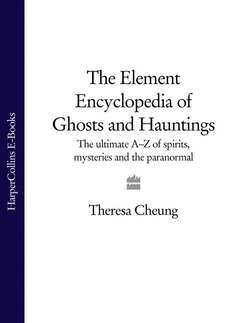Читать книгу The Element Encyclopedia of Ghosts and Hauntings: The Complete A–Z for the Entire Magical World - Theresa Cheung, Theresa Cheung - Страница 136
COTTINGLEY FAIRIES
ОглавлениеIn July 1917, 16-year-old Elsie Wright and her 10-year-old cousin Frances Griffiths claimed they could see fairies in the small wooded creek behind Elsie’s house in Cottingley, West Yorkshire. Elsie’s father dismissed their claims, and so one day the girls borrowed his camera to take a picture of them.
The picture, when developed, showed Elsie with a group of fairies dancing in front of her. A month later the girls took a picture of Elsie with a gnome. Elsie’s parents were startled by the photographs, but her father remained unconvinced. Her mother, however, took the pictures to a Theosophist meeting one evening, and soon the photos were published. The girls’ most famous supporter became Sir Arthur Conan Doyle, the creator of Sherlock Holmes. Conan Doyle printed the first two pictures in Strand Magazine in 1920 and three more photos a couple of years later. He then expanded his articles into a book, The Coming of the Fairies. Shortly after, Frances’s family moved away from Elsie’s, and the girls stopped seeing fairies.
In the decades that followed, the photographs were widely circulated and deemed false, and even Conan Doyle himself finally admitted that he may have been the victim of a hoax. It wasn’t until the 1980s, though, that Frances and Elsie admitted that they had faked the photographs to get back at the adults who had told them off for believing in fairies. They said that when Conan Doyle had got involved they didn’t want to embarrass him by admitting that the photos were faked. They also said that as young girls they had actually seen fairies, but that the fairies didn’t like to be photographed.
CRANDON, MINA STINSON [1888–1941]
This Boston medium, also known as Margery, left a controversial legacy behind her. Opinion is divided as to whether she was one of the greatest mediums of her day or a complete fraud.
Unusually for mediums, Crandon’s early life did not offer any hints of her future psychic power. It wasn’t until her divorce in 1918 and second marriage to prominent surgeon Le Roi Goddard Crandon, who had an interest in the paranormal and set up a psychic home circle, that her abilities began to surface. Soon she was demonstrating remarkable abilities as a medium managed by her control, Walter. Walter was in fact Mina’s brother who had died five years earlier, with whom she had been very close.
Several investigations of Crandon’s power were put together by prominent academics and psychical investigators, including Harry Houdini the magician, who was utterly convinced that she was a fraud. Despite causing bitter controversy, Crandon had many supporters at the American Society for Psychical Research, and a book published in 1925, Margery the Medium by Malcolm Bird, editor of the Scientific American, was very favourable to her.
Mina Crandon appeared to enjoy all the attention she received from press and public alike. By all accounts it wasn’t just her psychic powers that her supporters admired. She was a vivacious and charismatic person who was not adverse to holding séances in the nude and to having extramarital affairs with more than one of her investigators.
When asked on her deathbed if fraud had taken place, she refused to set the record straight. With the hint of a smile and a twinkle in her eye, she is said to have replied, ‘Why don’t you guess? You’ll all be guessing for the rest of your lives.’
